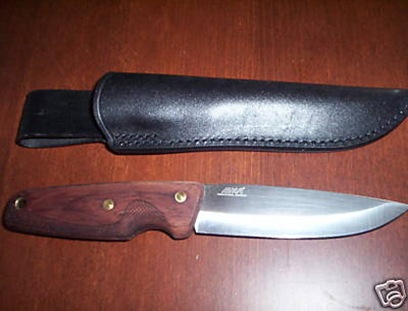If you ask people who practice bushcraft or wilderness living what is the most essential item in their kit and they will invariably answer that it's their knife. Many people go to great lengths to select their knife and usually only a custom knife will do. Of course, selecting a knife is very much a personal preference and it depends on what you're going to use it for.
For me, the jury's still out. I'm not sure if I'm 100% happy with a single knife (see updated cutting tools pages). Perhaps I'm the sort of person to select whatever tool or combination is right for the occasion.
I still haven't committed myself to an expensive custom knife and enjoy experimenting with the odd knife that comes my way. My latest addition to the family is an EKA Nordic W11. Ironically, this was the first knife I was going to purchase after my very first Frost's Clipper; but I decided to go for Phil Siddell's Companion Mark 2 instead. When I saw the EKA on Ebay, I decided to go for it, winning the auction at just £47-50. They normally retail around £20 or £30 more (£68-00 from Heinnie Haynes)
The EKA Nordic Hunter W11 is Swedish made 8 7/8in. overall with a 4 3/8 inch drop point blade. It's a full-length tang Sandvik 12C27 57-59 Rc out of 4mm with checkered Bubinga wood scales and lanyard hole.
I liked the shape of the knife from the start. Perhaps a 4mm thick 4 inch "all rounder" blade would, after all, be the most suitable general purpose knife for me. The reviews have been favourable and as a factory-made knife it's often compared to the Falkniven F1. The reviews threw up a few problems though, which prevented me from buying it in the first place. The first was the bevel and the second, the sheath.
When I received the knife I was delighted to notice that EKA had listened to feedback and had changed the sheath. Previous owners were bemoaning the fact that no matter how careful they were, the knife always cut the sheath when pulling out or putting away the knife. This must be a brand new version. Also it was obvious the knife has never been used. Chuffed.
Unfortunately the deep hollow grind with secondary bevel was still there. I'd read that this could be rectified with a little re-profiling and I was convinced that could do it! Of course, I'd do it my way, and not the recommended way with mouse mat and wet and dry. Out came the diamond hones and before long I was scrubbing away with the black coarse re-profiling hone throwing all caution to the wind. The aim was to extend the secondary bevel and then make it slightly convex...sort of! Not an easy task when you're leg is elevated in a plaster and you're using an upturned tea tray as a work-bench!
Quite a few hours later (actually many, many hours later) I had increased the original bevel size and there appeared to be a slight convex shape to the blade. I now worked my way down the hones to sharpen the edge, finishing off with a good strop.
Now I'm certainly not an expert and I'll have to give it a proper knife guru for them to tell me I've completely ruined it! Nevertheless it's now razor sharp. Whether it will stand up to a "bushcraft bashing" is another story, and of course, I won't be able to give a go for a few weeks yet.
The knife feels great in the hand. It has a nice weight to it, but not over heavy like some custom 4mm's I've handled (including the Woodlore). It fits my hand extremely well (I've got small hands) and I like the forefinger cut out and the serrated thumb grip on the spine. The handle is warm and I like the light checkered serrations on the lower part of the handle. Not bad so far.
As for performance, I can't say any more at the moment.
Needless to say, I enjoyed doing this little re-profiling task. Project Number One - done and dusted...Next!
Thanks for the visit,
Pablo.



No comments:
Post a Comment